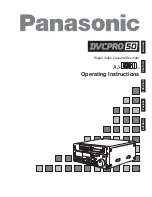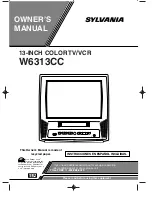
2-41
2.18.3
Linearity adjustment
The following flowchart shows the linearity check/adjustment
procedure.
While playing the recorded signal, adjust “VCO Center
Frequency (ME SP)” or “VCO Center Frequency (ME LP)” in
“Deck Section” of the Adjustment Utility.
To adjust VCO Center Frequency (ME SP) : Set Viterbi OFF.
To adjust VCO Center Frequency (ME LP) : Set Viterbi ON.
Record a color bar signal for about 5 minute s. (Note 6)
The error rate adjustment is complete when the minimum
error rate which is no higher than the typical value is
obtained. (Note 5)
Is the obtained error rate minimum
(almost the typical value)?
Yes
No
Fig. 2-18-4 PB ENV Waveform
PB ENV
waveform
Adjust variation
in the parallelism
HID waveform
CH1
CH2
Note 3 :
• The VHS section has an A/C head, and the first tracking
position can be locked using the CTL pulse and drum FF
when AT is off. Therefore, the linearity of the VHS section
can usually be adjusted with AT off. However, this adjust-
ment method is not available with the DV section, which
does not have the A/C head. If ATF is turned off, the DV
section performs tracking only of the speed system. There-
fore, as time passes, the servo will be lost and the linearity
adjustment will become difficult.
Note 4 :
• Since the speed servo function is active when ATF is off,
there will be no problem even if the DVC ATF function is
off, provided that it is for a few minutes.
2.18.4
PB switching point adjustment
The following flowchart shows the PB switching point adjust-
ment procedure.
The “PB Switching Point” in the Adjustment Utility of
the SSS software is adjusted automatically.
Load the alignment tape.
Play the alignment tape, then set “ATF” (Auto Tracking
Find) in “Deck Controller” of the SSS Software to ON.
(Note 3)
Connect an oscilloscope (CH: + Slope) and, while triggering
it with the HID signal, observe the ENV OUT waveform.
The linearity adjustment is complete if the PB ENV
waveform is ideally stable and varies ideally according to
the tracking variation. To close, play a prerecorded tape and
check the audio and video.
Is the PB ENV waveform ideally
stable and does it vary ideally
according to the tracking variation?
Yes
No
Repeat above steps
as required.
Ensure that the ENV OUT waveform is linear and parallel,
without a noticeable drop or variation in the overall level. If
the waveform linearity is poor or there is a noticeable drop
in level, adjust the guide roller by turning it with the roller
driver.
Set “ATF” (Auto Tracking Find) to OFF using “Deck
Controller” of the SSS Software (Note 4). Observe the ENV
OUT waveform to confirm that the overall waveform
balance and linearity levels vary in accordance with the
tracking variation as shown in Fig. 2-18-3.
Note 5 :
• The “typical value” refers to the following:
CH1 or CH2: < 498.; with Viterbi OFF. Inter-channel differ-
ence: < 10 times between CH1 and CH2.
Note 6 :
• It is desirable to use a brand-new tape or an unused sec-
tion of tape. This is to assure the adjustment reliability be-
cause using a damaged tape increases the error rate.
2.18.6
Error rate measuring method
It is not necessary to use the error rate jig (YTU93083) or a
frequency counter. The Service Support System Software
displays the error rates of video CH1, CH2 and totals. When
measuring the error rate of a channel, be sure to total the
values of the video and the audio errors.
2.18.5
Error rate adjustment
The following flowchart shows the error rate adjustment pro-
cedure.
Содержание SR-VS20E
Страница 5: ......
Страница 41: ...2 20 ...















































